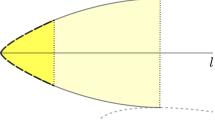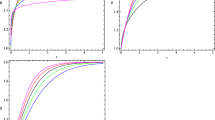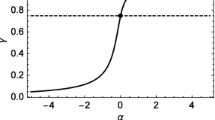Abstract
Starting with a “relativistic” Schrödinger Hamiltonian for neutral gravitating particles, we prove that as the particle number N→∞ and the gravitation constant G→0 we obtain the well known semiclassical theory for the ground state of stars. For fermions; the correct limit is to fix GN 2/3 and the Chandrasekhar formula is obtained. For bosons the correct limit is to fix GN and a Hartree type equation is obtained. In the fermion case we also prove that the semiclassical equation has a unique solution — a fact which had not been established previously.
Dedicated to Walter Thirring on hid 60th birthday
Work partially supported by U.S. National Science Foundation grant PHY 85–15288-A01
Work supported by Alfred Sloan Foundation dissertation Fellowship
Access this chapter
Tax calculation will be finalised at checkout
Purchases are for personal use only
Preview
Unable to display preview. Download preview PDF.
Similar content being viewed by others
References
Auchmuty, J., Beals, R.: Variational solutions of some nonlinear free boundary problems. Arch. Ration. Mech. Anal. 43, 255–271 (1971). See also Models of rotating stars. Astrophys. J. 165, L79–L82 (1971)
Chandrasekhar, S. : Phil. Mag. 11, 592 (1931)
Chandrasekhar, S. : Astrophys. J. 74, 81 (1931)
Chandrasekhar, S. : Monthly Notices Roy. Astron. Soc. 91, 456 (1931)
Chandrasekhar, S. : Rev. Mod. Phys. 56, 137 (1984)
Conlon, J. : The ground state energy of a classical gas. Commun. Math. Phys. 94, 439–458 (1984)
Daubechies, I.: An uncertainty principle for fermions with generalized kinetic energy. Commun. Math. Phys. 90, 511–520 (1983)
Daubechies, I., Lieb, E.H.: One-electron relativistic molecules with Coulomb interaction. Commun. Math. Phys. 90, 497–510 (1983)
Fefferman, C., de la Llave, R. : Relativistic stability of matter. I. Rev. Math. Iberoamericana 2, 119–215(1986)
Fowler, R.H.: Monthly Notices Roy. Astron. Soc. 87, 114 (1926)
Herbst, I.: Spectral theory of the operator (p 2 + m 2 ) 112 ze 2 /r. Commun. Math. Phys. 53, 285–294 (1977)
Herbst, I.: Errata ibid. 55, 316 (1977)
Kato, T. : Perturbation theory for linear operators. Berlin, Heidelberg, New York: Springer 1966. See Remark 5.12, p. 307
Kovalenko, V., Perelmuter, M., Semenov, Ya.: Schrödinger operators with. J. Math. Phys. 22, 1033–1044 (1981)
Landau, L.: Phys. Z. Sowjetunion 1, 285 (1932)
Lieb, E.: The number of bound states of one-body Schrödinger operators and the Weyl problem. Proc. Am. Math. Soc. Symp. Pure Math. 36, 241–252 (1980). See also: Bounds on the eigenvalues of the Laplace and Schrödinger operators. Bull. Am. Math. Soc. 82, 751–753 (1976)
Lieb, E. : Existence and uniqueness of the minimizing solution of Choquard’s nonlinear equation. Stud. Appl. Math. 57, 93–105 (1977)
Lieb, E.: Variational principle for many-fermions systems. Phys. Rev. Lett. 46, 457–459 (1981)
Lieb, E.: Variational principle for many-fermions systems Errata ibid. 47, 69 (1981)
Lieb, E. : Thomas-Fermi and related theories of atoms and molecules. Rev. Mod. Phys. 53, 603–641 (1981); Errata ibid. 54, 311 (1982)
Lieb, E. : Density functional for Coulomb systems. Int. J. Quant. Chem. 24, 243–277 (1983)
Lieb, E., Oxford, S. : An improved lower bound on the indirect Coulomb energy. Int. J. Quant. Chem. 19, 427–439 (1981)
Lieb, E., Simon, B. : Thomas Fermi theory of atoms, molecules and solids. Adv. Math. 23, 22–116(1977)
Lieb, E., Thirring, W. : Gravitational collapse in quantum mechanics with relativistic kinetic energy. Ann. Phys. (NY) 155, 494–512 (1984)
Lions, P.-L.: The concentration compactness principle in the calculus of variations; the locally compact case I. Ann. Inst. H. Poincaré Anal, non lineaire l, 109–145 (1984)
Messer, J. : Lecture Notes in Physics, Vol. 147. Berlin, Heidelberg, New York : Springer 1981
Morrey, C.B., Jr.: Multiple integrals in the calculus of variations, Theorem 5.8.6. Berlin, Heidelbereg, New York: Springer 1966
Ni, W.M. : Uniqueness of solutions of nonlinear Dirichlet problems. J. Differ. Equations 5, 289–304(1983)
Straumann, S. : General relativity and relativistic astrophysics. Berlin, Heidelberg, New York: Springer 1984
Thirring, W.: Bosonic black holes. Phys. Lett. B127, 27 (1983)
Weder, R. : Spectral analysis of pseudodifferential operators. J. Funct. Anal. 20, 319–337 (1975)
Weinberg, S.: Gravitation and cosmology. New York: Wiley 1972
Hamada, T., Salpeter, E. : Models for zero temperature stars. Astrophys. J. 134, 683 (1961)
Shapiro, S., Teukolsky, S. : Black holes, white dwarfs and neutron stars. New York: Wiley 1983
Ruffini, R., Bonazzola, S. : Systems of self-gravitating particles in general relativity and the concept of an equation of state. Phys. Rev. 187, 1767–1783 (1969)
Author information
Authors and Affiliations
Editor information
Editors and Affiliations
Rights and permissions
Copyright information
© 2001 Springer-Verlag Berlin Heidelberg
About this chapter
Cite this chapter
Lieb, E.H., Yau, HT. (2001). The Chandrasekhar Theory of Stellar Collapse as the Limit of Quantum Mechanics. In: Thirring, W. (eds) The Stability of Matter: From Atoms to Stars. Springer, Berlin, Heidelberg. https://doi.org/10.1007/978-3-662-04360-8_32
Download citation
DOI: https://doi.org/10.1007/978-3-662-04360-8_32
Publisher Name: Springer, Berlin, Heidelberg
Print ISBN: 978-3-662-04362-2
Online ISBN: 978-3-662-04360-8
eBook Packages: Springer Book Archive




